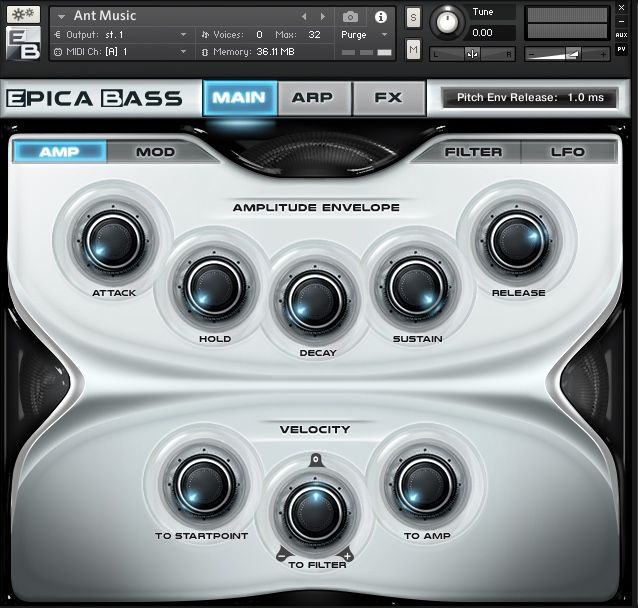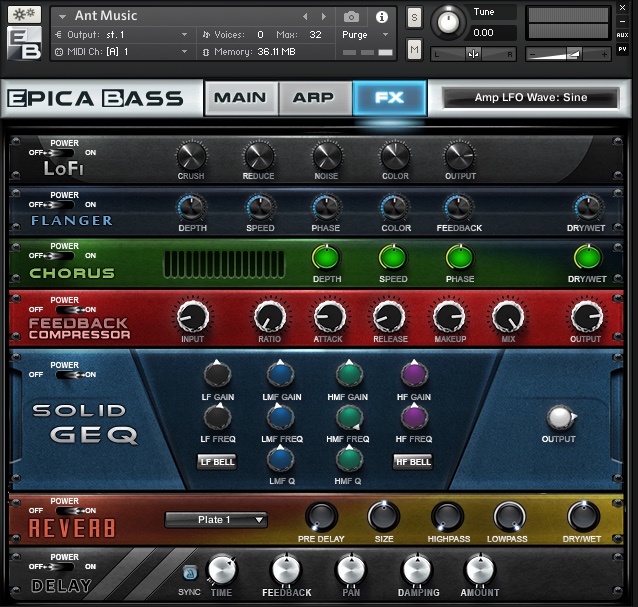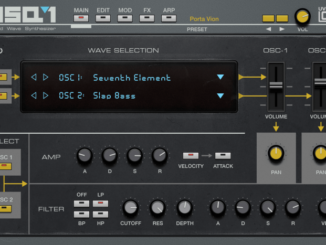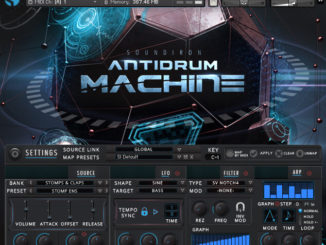Zero-G Epica Bass by Sam Spacey is a true bass factory for Kontakt Player that allows you to design your personal sound.
Currently, there is a Kontakt library for almost every sound. From atmospheric textures, symphonic strings, sound effects to sampled analog bass sounds. The last one fits to the Zero-G Epic Bass. It is a huge Kontakt-powered sample library with more than 25.000 24bit mono samples. There are sampled from vintage analog Synthesizers (ARP Odyssey Mk3, Sequential Pro-1, Oberheim SEM, Oakley Modular, …). The sounds were not only recorded directly from the devices but also processed further with various hardware effects.
One might wonder why one needs a sample library full of analog bass sounds, especially where everyone has multiple software or hardware synthesizers at home. In my opinion, it’s a time factor and convenience. Not everyone wants to spend a lot of time on the synth but want to play with ready-to-use sounds. Maybe EB is your perfect bass instrument, which saves a lot of time.
Synthesis Engine
The samples are supported by a complex but easy-to-use Kontakt synthesis engine that is divided into three points: Main, ARP, and FX. Let’s start with the main section, where the sample becomes an instrument. This section is subdivided in an amp, mod, filter and LFO page. On the first, there is an ADHSR amp envelope and the option to route velocity to the sample point, filter, and amplitude. Very useful and a nice addition is the velocity to start point function with which you add the bass sound some life.
On the second page, the engine features a pitch ADR envelope with an env amount, random note pitch, pitch drift, portamento as well as modulation options for the sample start point. Further, it features a filter block with 6 different types including 2x lowpass, bandpass, highpass, vowel and format. With the last two, you can sculpt very interesting and usual bass sounds. Three LFO’s, each with 5 different waveforms and different routing options rounds up the main section of the engine.
In this wide range of functions, I miss in the main section a possibility to change the sound source. For example, with a drop-down menu, as we know from many Kontakt libraries. In this case, you need to choose another presets to get another sound source. I also lack a function with which you can layer two basses together, for example. On the second page, we enter the rhythmic part where a fully customizable arpeggiator is installed. Beside classic arp features, it offers different scales, a repeat, and a swing parameter. So nothing unusual or very innovative, more bread and butter.
Multi-FX
Last but not least there is a multi-effect processor designed like a hardware rack. It features a lo-fi (bit-crusher), flanger, chorus, feedback compressor, solid GEQ, reverb, and delay. The best effect here is the reverb, which is more specifically called a convolution reverb with 22 impulse responses. All of them are nice and they cover a large number of reverb sounds.
The effect section is nothing special, but a very classic multi-FX processor that fits well in this engine. Very easy to use, no submenus and all functions at a glance.
Bass Quality & Versatility
Epica Bass scored points in the sound test with a very high quality. I could not find any aliasing of stretched notes during the test. Plus, there are at least six “round robins” for each note, so the instrument sound very authentic and not like a static sampled-instrument. So you get a slightly different timbre each time you hit a key like on an analog Synthesizer.
The 437 instruments big library is definitely versatile. From classic analog basses with lots of character, modern techno-oriented basses to experimental ones, everything is on board. If the right sound is not available which is almost impossible in my opinion, you can easily modify the presets and design your own bass sound. The numerous features including various filters, modulation options, and the large multi-fx processor make this possible.
Zero-G Epica Bass Review Conclusion
Epica Bass leaves an excellent impression, even if it is “just” a Kontakt Player library. This can score with a very nice and easy-to-use GUI, excellent sampled bass sound content using the Round Robin method and many ways to change sounds. Also, the included presets can convince completely and are with many electronic music directions (EDM, Synthwave, …) compatible. Something not so great is that there is no way to change the sound sources in a patch.
In short: EB by Sam Spacey is a perfect virtual instrument for musicians who want to have the right and great-sounding bass sounds at hand without spending a lot of time on their own.
Pro
- high-quality samples
- authentic sounds
- intuitive interface
- great and versatile effects
- NKS + Kontakt Player support
- huge amount of useable sounds
- tons of options for creating own presets
Contra
- no internal layer system (layering two basses p.ex)
- no option to replace the source sound via a drop-down menu in the interface
Zero-G Sam Spacey Epica Bass is available now for $77 USD and is compatible with the free Kontakt Player.
Available at our partner






Be the first to comment